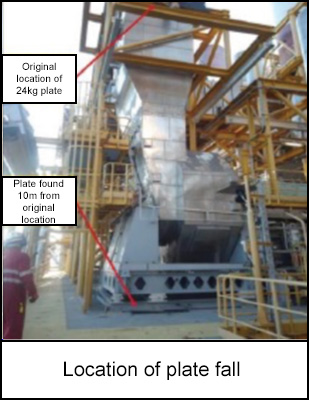-
What happened?
When lowering the boom back into its resting position, a crane operator identified that a broom cradle was missing a piece of rubber buffer plate (weight approximately 24kg (53lbs)).
The crew immediately examined the area and found the missing plate on the deck (approximately 10m (33 feet) below its original location).
DROPS calculations indicate this incident could have had a fatal consequence.

-
Why did it happen?
The resting position of the auxiliary hook block was lower than the bottom edge of the buffer plate.
The auxiliary hook block had a flat shape. As such, it could catch on the buffer plate and remove it from the structure.
The buffer plate was attached to the structure via glue and bolting.
This method of attachment was unable to withstand the shear force from the auxiliary hook block.

-
What did they learn?
Visually check the condition of buffer plates before and after crane operations.
Establish procedures to monitor the potential for dropped objects arising from crane operations.
Crane operators should be guided into and from the boom rest.

-
Ask yourself or your crew
Do cranes at your site have buffer plates in the broom cradle? Is it possible that the auxiliary
hook could catch on a buffer plate and dislodge it?
Do you visually check the condition of buffer plates before and after crane operations? Are crane operators at your site guided into and from the boom rest?
What procedures are in place at your site to monitor the potential for dropped objects arising from crane operations?
How do you manage line of fire risks for personnel as a result of dropped objects during crane operations?

Add to homescreen
Content name
Select existing category:
Content name
New collection
Edit collection
What happened?
When lowering the boom back into its resting position, a crane operator identified that a broom cradle was missing a piece of rubber buffer plate (weight approximately 24kg (53lbs)).
The crew immediately examined the area and found the missing plate on the deck (approximately 10m (33 feet) below its original location).
DROPS calculations indicate this incident could have had a fatal consequence.

Why did it happen?
The resting position of the auxiliary hook block was lower than the bottom edge of the buffer plate.
The auxiliary hook block had a flat shape. As such, it could catch on the buffer plate and remove it from the structure.
The buffer plate was attached to the structure via glue and bolting.
This method of attachment was unable to withstand the shear force from the auxiliary hook block.
What did they learn?
Visually check the condition of buffer plates before and after crane operations.
Establish procedures to monitor the potential for dropped objects arising from crane operations.
Crane operators should be guided into and from the boom rest.
Ask yourself or your crew
Do cranes at your site have buffer plates in the broom cradle? Is it possible that the auxiliary
hook could catch on a buffer plate and dislodge it?
Do you visually check the condition of buffer plates before and after crane operations? Are crane operators at your site guided into and from the boom rest?
What procedures are in place at your site to monitor the potential for dropped objects arising from crane operations?
How do you manage line of fire risks for personnel as a result of dropped objects during crane operations?
When lowering the boom back into its resting position, a crane operator identified that a broom cradle was missing a piece of rubber buffer plate that fell to the deck below.
Original material, and accompanying slideshow, courtesy of Safer Together
To access the PDF and PowerPoint versions, please visit https://www.safertogether.com.au/resources/sharing-library/lifting-person-in-line-of-fire-leb-toolbox












